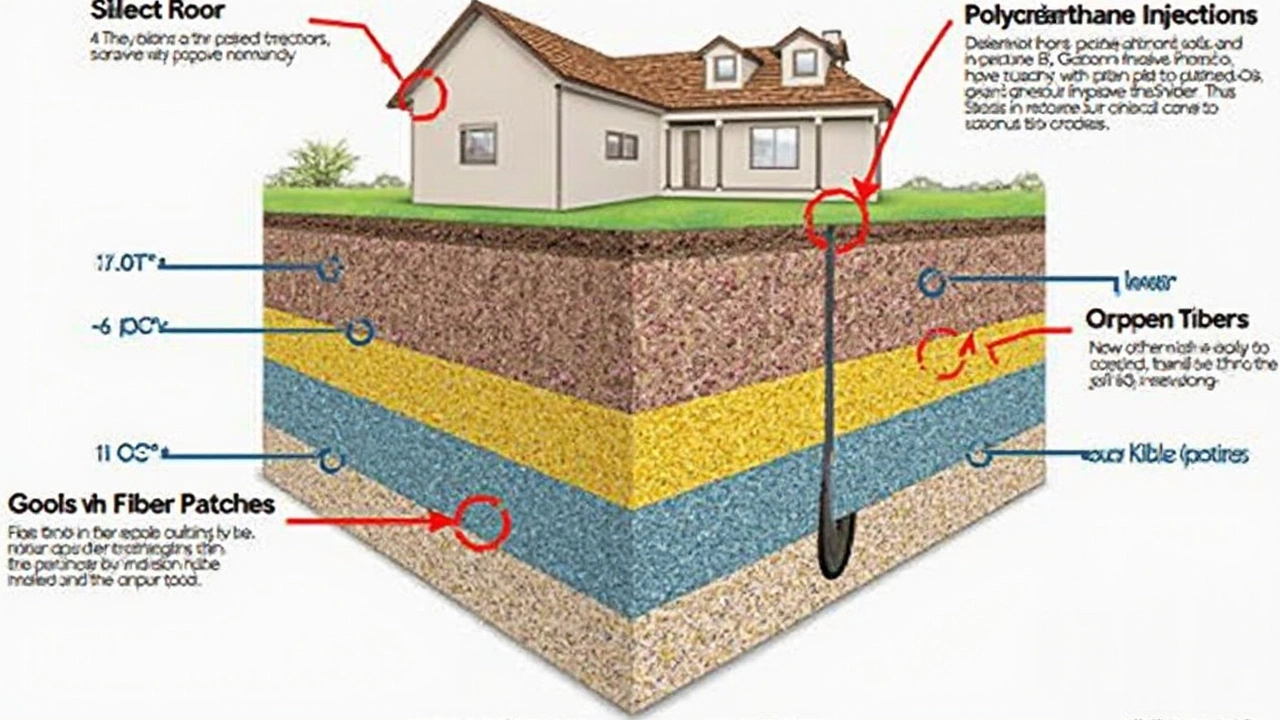So you've noticed a crack in your foundation and you're trying not to panic. First off, take a deep breath. Not all cracks spell disaster for your home. Some are just normal and happen as the house settles over time. However, if the crack is wide enough to wedge a coin in, it’s time to roll up your sleeves and think about repairs before things get worse.
When it comes to foundation crack repair, knowing the nuts and bolts of different methods can really make a difference. For instance, using polyurethane injections might be your go-to if you're dealing with non-structural cracks caused by shrinkage or minor settlement. It's flexible, making it a good option for areas prone to slight movements. But if the crack threatens the building’s structural integrity, epoxy injections, offering a more rigid fix, could be your knight in shining armor.
Choosing the best repair method isn't just about what's cheapest or easiest. Consider the type of crack, the cause, and even your future plans for the home. After all, a solid foundation not only keeps the house standing tall but also saves you money and headaches in the long run.
- Understanding Foundation Cracks
- Assessing the Damage
- Polyurethane Injections
- Epoxy Injections
- Carbon Fiber Patches
- Preventive Measures
Understanding Foundation Cracks
Foundation cracks, the very mention of it can make anyone who owns a home a bit anxious. But not all cracks are the end of the world. It’s important to get familiar with them before jumping to conclusions or having sleepless nights.
Cracks start small, sometimes even as hairline fractures, and these are often due to the house settling as it adjusts over time. Imagine your home giving itself a little stretch. But when they get wider or show up suddenly, that’s when you need to pay extra attention. Broadly speaking, cracks can be vertical, horizontal, or diagonal, and each tells its own story.
Vertical cracks are the most common and usually harmless. They often result from natural settling or concrete shrinking as it dries. Think of them as the least worrisome. However, it’s always good to monitor these, especially if water starts seeping through.
Horizontal cracks are more troublesome. They often mean pressure or moisture is pushing against the foundation. This could be due to soil expansion, more often in areas with freeze-thaw cycles. These cracks can affect the structural integrity of your home, making them urgent to address.
Diagonal cracks fall somewhere in between in terms of seriousness. These often appear because of uneven settling or foundation shifting due to soil conditions. If they’re wider at one end, this could signal some movement that you'd want to look into.
It’s helpful to keep a watchful eye on any changes. Measure the width of the cracks occasionally to catch any growth early. Taking regular photos can help as comparisons are made down the line.
| Type of Crack | Common Cause | Urgency |
|---|---|---|
| Vertical | Natural settling | Low |
| Horizontal | Pressure from soil | High |
| Diagonal | Uneven settling | Medium |
Spotting and understanding these cracks is the first step. A critical part of maintaining your home’s foundation health isn’t just patching up spots but knowing the root causes. That’s what will ultimately save money and stress in the long run. As always, if you’re unsure about your observations, calling in a professional might just be the best call.
Assessing the Damage
Spotting a crack in the foundation is only half the battle—figuring out why it's there and how serious it is? That’s the real deal. Start by sizing it up. Are we talking hairline crack or one you could lose a credit card in? Generally, smaller cracks (less than a quarter-inch wide) might just be paper tigers, often due to minor shrinkage.
But what if the crack's wide and uneven? That could be a sign of settling or more serious pressure issues. Grab a ruler or measuring tape and note dimensions—width, length, and depth. Also, observe if new cracks are showing up or the old ones are getting bigger. These changes could mean there’s ongoing movement or stress on the foundation.
Here’s a simple checklist to guide you:
- Foundation crack repair: Identify if cracks are vertical, horizontal, or diagonal—each tells a different story. Vertical cracks could be due to settling, while horizontal ones might indicate pressure from soil.
- Water presence: Check for any water seepage. Dampness or water tracking can hint towards a leaking foundation which might worsen cracks.
- Surrounding environment: Consider recent construction, changes in nearby drainage systems, or even harsh weather. These can influence your home's stability.
If you’re feeling a bit like Bob the Builder at this point and still iffy about the situation, calling in a pro might be money well spent. They can typically offer a detailed assessment, even using tools like laser levels to check for possible shifts.
Remember, dealing with foundation repair early can be a big money-saver. So, don’t just walk away from that crack. Give it the attention it needs, and your home will thank you.
Polyurethane Injections
Alright, let’s dig into how polyurethane injections can help fix those pesky cracks. Essentially, this method involves injecting a flexible foam into the crack. What makes it stand out? Well, when polyurethane gets in contact with water, it expands. This makes it perfect for sealing leaks and non-structural cracks you might find in basement walls.
Polyurethane is the go-to for many homeowners since it’s super versatile and quick to apply. Whether you’re dealing with hairline cracks or slightly larger gaps, this foam fits nicely and fills the space completely. The best part? It doesn’t lose its flexibility, which is a big plus if your foundation shifts a bit with changes in moisture levels or temperature.
But let’s not get too carried away; it's not the cure-all. While it’s superb for water-sealing, it doesn’t add structural strength to a foundation. So, if you’re dealing with issues like uneven floors or doors that don’t quite close properly, you might need to look into other foundation repair methods.
Here’s a quick rundown on how polyurethane injections usually work:
- Preparation and Cleaning: The crack is cleaned out to remove any debris or loose material.
- Injection Ports Setup: Little plastic ports are placed along the crack length, which are used for injecting the polyurethane.
- Injecting the Foam: The foam is injected through these ports. As it reacts with water, it expands and fills up every nook and cranny.
- Sealing: After the foam sets, the ports are removed and the surface is sealed to ensure everything stays dry.
All in all, polyurethane injections are fantastic for sealing out moisture and making sure your basement doesn’t turn into a swimming pool every time it rains. But remember, if your problem seems more serious, like affecting the structural integrity, you might want to explore other options like epoxy or even getting a professional assessment to be sure you're on the right track.

Epoxy Injections
When it comes to fixing those stubborn foundation cracks that threaten your home's structure, epoxy injections are like the superhero of repair methods. These injections work wonders by bonding cracks from the inside, restoring the original strength of the concrete. It's not just a patch-up job; it's like giving your foundation a second chance at life.
The process starts with cleaning out the crack to remove any dirt or debris. This ensures the epoxy can fully penetrate and bond well. Then, small injection ports get attached along the length of the crack. The epoxy resin is injected under pressure, filling the crack all the way to the outside edge, leaving no room for failure.
Now, you're probably wondering, why choose epoxy over other methods? It's all about strength and permanence. Epoxy actually makes the repaired area stronger than the original concrete, which is why it's often used in foundation repair for structural cracks. It's like reinforcing your home with super glue, but stronger.
But keep in mind, the effectiveness largely depends on the application. If the crack is caused by an underlying issue like soil movement, fixing the crack alone won't do the trick. You'll need to address the root problem to prevent future damage.
| Factor | Details |
|---|---|
| Cost | Generally ranges from $300 to $700 per crack |
| Application Time | Can take 1 to 2 hours per crack |
| Strength | Restores and often surpasses original concrete strength |
When you're ready to go ahead with epoxy injections, it's a smart move to consult with a foundation expert. They'll assess the damage and ensure that this method is the right fit for fixing your home's specific issues. Getting it right means peace of mind and a solid foundation for years to come.
Carbon Fiber Patches
Imagine your foundation crack repair like a trip to the tailor. If your foundation has a bigger split, you'll need a heavy-duty fix—like carbon fiber patches. These are pretty much the unsung heroes of crack repair, especially for vertical or diagonal cracks caused by a shifting foundation or soil pressure.
So, what makes carbon fiber patches so effective? Well, just like a superhero shield, carbon fiber is incredibly strong yet lightweight. It doesn’t stretch or break easily. When these patches are bonded to your concrete wall, they work alongside the existing structure to prevent further movement, essentially holding everything in place.
Here's how it typically goes down:
- Surface Preparation: The wall surface must be cleaned and roughened, so that the patch will stick properly. Dust, dirt, and paint are cleared away.
- Applying the Epoxy: A layer of special epoxy adhesive goes onto the crack and the surrounding area. This stuff helps the patch adhere securely to the wall.
- Attaching the Carbon Fiber: The carbon fiber strip is pressed onto the epoxy. These strips are incredibly strong, reinforcing the wall like rebar in concrete.
- Curing: Once everything is in place, the adhesive needs time to harden, usually 24 to 48 hours. No shaking the walls during this time!
One big advantage here is their low-key profile. Since the carbon fiber patches don’t jut out from the wall, you can paint over them. Voilà! It looks as good as new.
An interesting fact—to put this into perspective, these patches are so tough and effective that they’re used in aerospace applications. If it’s good enough for a spaceship, it’s good enough to keep your basement intact.
Overall, carbon fiber patches stand out for their strength, ease of application, and low visibility. While they might cost a bit upfront, knowing your home’s foundation is solid—and that you can still spruce up the house with your favorite paint—is worth every penny.
Preventive Measures
Kicking potential foundation crack repair issues to the curb begins with some good ol’ prevention. You might not be able to avoid every single crack forever, but regular maintenance goes a long way in keeping your foundation shipshape.
First, check your drainage. Water pooling around the base of your house is like rolling out the welcome mat for trouble. Ensure your gutters are clean and extend downspouts to direct water away from your foundation. A simple fix like this can save you from more complicated headaches down the road.
Keep an eye on your landscaping, too. Trees and shrubs are great, but their roots can sneakily creep under your foundation, causing soil shift. Plant trees away from the foundation or consider root barriers if space is tight.
Temperature changes can also stress your foundation, causing cracks over time. In places with harsh winters or scorching summers, maintaining consistent moisture levels in the soil surrounding your home is crucial. Water your foundation during dry spells and ensure the ground around the foundation slopes away at a gentle angle.
| Tip | Action |
|---|---|
| Check for Cracks | Inspect your foundation annually, especially after extreme weather. |
| Monitor Water Usage | Avoid excess water near the foundation. Fix leaks promptly. |
You might also want to catch potential issues with annual professional inspections. Experts can spot tiny problems before they evolve into big, expensive ones. When overlooked, small issues can spiral, so consider these occasional checks as cheap insurance.
Finally, if you're planning renovations, be cautious about the extra load on your foundation. Consult with structural engineers to ensure your foundation can handle the changes. By staying proactive, you'll help protect your home sweet home, and possibly avoid the dreaded deep dive into costly foundation crack repair methods.





